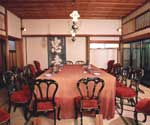Old history and affluent culture ― Stage of historical dramas
Shimonoseki City, located at the western edge of Honshu, has prospered as a key nexus for marine and land traffic since time immemorial by making use of its geographical advantages especially its location; it faces Kyushu across the Kanmon Straits and stands close both to the Korean Peninsula and the Chinese continent. Such advantages have also encouraged an influx of different cultures introduced from the continent to the City, making it a melting pot of cultural interaction. Shimonoseki City also has relationships with many stages of Japanese history as a place where various dramas have unfolded.
The municipalization of Akamagaseki City ― First municipalization
On 1 April 1883 when the city status was first given in Japan, Shimonoseki was founded as the only city in Yamaguchi Prefecture and at the time was named Akamagaseki City. The population of those days was 30,739 and the City stretched over a long thin area of 5.36 square kilometers along the straits reaching from Mimosusogawa River to Izaki. Due to mounting pressure from amongst the citizens, the city name was changed from Akamagaseki to Shimonoseki in 1902, which was a very rare occurrence in Japan at that time.
The Peace Conference, ending the First Sino-Japanese War ― A venue for the international conference
The peace conference after the First Sino-Japanese War took place at Shunpanro in Shimonoseki in 1895. Negotiations were held between Prime Minster Ito Hirobumi who had full power to act on behalf of Japan and Li Hongzhang negotiating on behalf of China. The Treaty of Shimonoseki was signed and Japan acquired its position as a world power.
The Start of the Kampu Route between Shimonoseki and Busan ― A gateway to the continent
In 1905, the Kampu ferry began its service between Shimonoseki and Busan and with Shimonoseki, acting as a gateway to the continent, the flow of people increased. The beach of Hosoe was called “Sanyo’s beach” and the hustle and bustle of the beach still continues to this today. Consequent to these developments the British consulate was opened in 1901, becoming one of eight consulates that were opened in total. Shimonoseki also became the starting point for railway development in western Japan with Sanyo Railways opening in 1901.
The opening of the Kanmon Railway Tunnel ― the Completion of Kanmon’s main artery
During the War of the Pacific, the Kanmon Railway Tunnel was opened in November 1942. The present Shimonoseki station was opened in Takezaki town which became the new downtown area taking over from the Hosoe town location.
Massive Air Raids on Shimonoseki followed by reconstruction ― in the middle of the war and postwar
Massive air raids hit Shimonoseki twice on 29 June and 2 July 1945 when the City burned to the ground. The number of victims was 46,084 including 324 deaths whereas the number of the buildings damaged was 10,168. Many mines were also dropped in the Kanmon Straits to put in place a naval blockade. The postwar reconstruction work progressed steadily. The construction of the Kanmon Railway Tunnel, which was suspended due to war damages, restarted in 1952 and was opened in 1958. The construction of the Koyagawa Dam, which was suspended due to lack of materials during the war, was also completed in 1954. The port was also developed after its construction was completed.
The Great Merger of the Showa Era ― The Birth of Kikugawa, Toyota, Toyoura and Hohoku Towns
After the war, administrative work relating to social welfare and health was passed to the municipality. To achieve effective administrative work, streamlining of local government was essential. Against this background, municipal merger progressed based on the Municipal Merger Promotion Law enacted in 1953 and the Law for the Promotion of the Construction of New Municipalities enacted in 1956. Toyota Town was newly created as a result of the merger of Tonoi Village, Toyota-naka Village, Nishiichi Town and Toyota-shimo Village in 1954. Kikugawa Town was also created by the merger of Toyohigashi Village, Kikugawa Village and part of Utsui Village as well as Toyoura Town being created by the merger of Toyonishi Village, Kuroi Village, Kawatana Village and Uka Village in 1955. Hohoku Town was created by the merger of Kamitama Village, Tsunoshima Village, Kanda Village, Agawa Village, Awano Village, Tasuki Village and part of Uka Village.
Development of Transportation Facilities ― Development of Transportation in Sanyo and Sanin areas
Before the coming of the Showa Era, the first bus services started between Higashi Station and Karato in 1913 and the Choshu Railway started its services between Higashi-shimonoseki and Kogushi in the following year (1914). Taxi services also started in 1916. The first tram services started between Hatabu and Higashi-shimonoseki in 1925. As for the inland area, Nagato Railways opened between Ozuki and Nishiichi in 1918. In 1933 when all the Sanin lines opened, Shimonoseki City became a center for transportation throughout both the Sanin and Sanyo areas.





